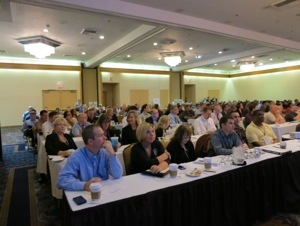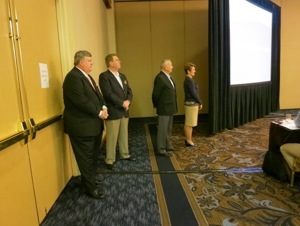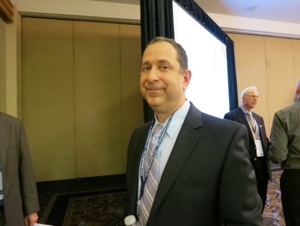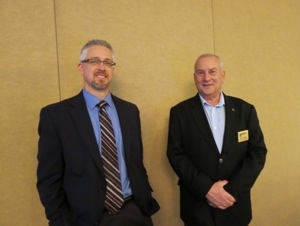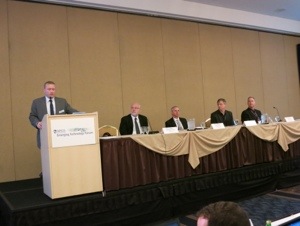Public Safety & Emerging Technology: NG9-1-1, Text to 9-1-1 & More
“Don’t be scared; be smart,” Mark S. Adams, director, principal architect networks and communications, Northrop Grumman Information Systems, advised attendees of the APCO International Emerging Technology Forum on Jan. 30. Although Adams was specifically speaking to the need to secure data and networks, the advice could apply to every topic addressed during the forum.
Wednesday morning’s speakers focused on the next generation PSAP, NG9-1-1 and the new public safety ecosystem.
The increasing amount of data that will be available to 9-1-1 PSAPs and managing that data were major concerns echoed by all the speakers. A common theme stated eloquently by Cassidian’s Jeremy Smith was, “How do we cut through the noise and get to the actionable information?”
APCO International President Terry Hall kicked off the two-day event by welcoming the more than 200 public safety professionals in attendance.
NG9-1-1
The first speaker of the day was Kathy McMahon, director of public safety for Agero and former technical services manager and interim director of Comm Center & 9-1-1 Services for APCO International.
McMahon introduced the topic of planning for NG9-1-1. “It’s really important that everyone get and stay on the same page from the ground up,” said McMahon. “How we do things on the East Coast is very different from how you do things on the West Coast.”
To get set up on NG9-1-1, you have to have a network. That’s the one thing you must have in order to have an NG9-1-1 system. Some questions that may help you get started: Does your state operate a secure IP network that could be used for emergency services or delivery of 9-1-1 calls? Have you assessed requirements for bandwidth to ensure that the current network will handle future traffic? How will it be managed?
“The foundation of the future is the network itself,” said Charles Vick, product management/development, public safety for Verizon Enterprise Solutions, during his lunch presentation.
“NG9-1-1 is really just a subset of IP-based emergency communications,” said McMahon. “9-1-1 calls are only one part of the public safety ecosystem. NG9-1-1 is much, much more than 9-1-1.”
NG9-1-1 is introducing public safety to a whole new vocabulary. “A call becomes an event,” explained Smith during his presentation later in the morning. “The request for service arrives in many forms.” However, he anticipates that public safety will be using “call” for years to come.
McMahon defined some of the new terms and acronyms accompanying NG9-1-1: Presence Information Data Format-Location Object (PIDF-LO). Basically, this one means are you on a network and where? ESRP is the Emergency Service Routing Proxy and PRF is Policy Routing Function. “Policy routing is going on today in the background,” said McMahon
“The Location Information Server (LIS) is a more sophisticated way of doing what ALI is doing for us today,” she said.
A lot of people have heard that under NG9-1-1 MSAG validation will no longer be happening. However, “Location validation is not going away,” assured McMahon. The function will simply be handled in a different database. “The concept of location validation is not going away.”
Some people see NG9-1-1 as an interoperability utopia, McMahon said. “As you’re planning for your interoperability utopia, you have to have on your radar how your neighbors train their personnel. … Standardized training is going to be critical as you move forward with next gen. If you haven’t started on the same page, there are going to be a lot of challenges.”
Among those challenges, what to do with all that additional data you’ll have access to. “Medical history is not important when you’re taking a robbery call,” said McMahon. For every assumption we make on how we think information should be used, without oversight or some sort of quality assurance process, we won’t know if we’ve made good decisions.”
Text to 9-1-1
There have been “13,433 public attempts to text 9-1-1 since October 2012,” said Seth Sonenthal, product manager for TeleCommunication Systems (TCS) Inc. He turned the discussion to text to 9-1-1 in his presentation, SMS 9-1-1 — Debate Has Ended; Rollout Begins. “Public demand is there. The public does want this.”
Sonenthal said there are three interfaces available today to enable PSAPs to accept texts:
- Legacy PSAP — TTY
- Transition PSAP — Web services
- NextGen PSAP — ESInet
All have their challenges, and all will require training and practice to implement. “Give personnel a safe area to learn and to express concerns,” said Sonenthal. “Early training, early training, early training. Early training means everything. … The more preparation you can give the people who will be implementing this, the better.”
The path to text to 9-1-1 has been established, and the top four carriers have agreed to quarterly self report on their progress. The four major carriers will provide standardized bounce-back messages to text-to-9-1-1 messages by June 30, 2013. General service will be available by May 15, 2014. The carriers will have a six-month go-live triggered by a PSAP readiness letter.
John Snapp, senior technical officer for Intrado, also addressed text to 9-1-1. “Interoperability is really important,” he said. “We don’t want islands of operability out there.”
Snapp defined some terms specific to texting:
SMS – Short Message Service
SMSC – Short Message Service Center
SMPP – Short Message Peer to Peer
LBS – Location Based Services
MLP – Mobile Location Protocol
MMS – Multimedia Messaging Service
TCC – Text Control Center
ESRP – Emergency Services Routing Proxy
MMES – Multimedia Messaging Emergency Services
TCC has been designed to bridge the gap between the carrier and the PSAP.
How it works. SMS is NOT a conversation. It’s an individual message. It shows one to one. So how do you create a “conversation” with the calltaker?
Mobile texts to 9-1-1. Networks send to TCC.
TCC queries LBS for cell location.
TCC sets up “conversation” with PSAP.
PSAP sends message back to user.
From that point forward, the incoming messages will route to the same calltaker until the PSAP releases the “conversation.”
You want the “one screen to handle them all.”
Sonenthal assured the public safety audience that non-initialized phones will not be text-to-9-1-1 enabled. “We do not see uninitialized phones being supported or incorporated into this service.”
The goal is to ensure that texts can be tracked to a live person. Unlike typical SMS messages, which are single events, texts to 9-1-1 will be treated like “conversations.”
“We’re going to see a lot of activity over the next two years, including FCC and regulatory action. Carriers should be trialling by the end of 2013,” said Sonenthal.
The next step is for PSAPs to start asking questions and making decisions about “what works for you and when you’re ready to go forth and act.”
The Public Safety Ecosystem
Smith’s presentation was the Next Generation Public Safety Communications Ecosystem. Smith said, “Times are changing.”
The goal is to improve public safety, and he advised attendees to consider the consequences on the telecommunicators. “Audio can already have a severe emotional impact,” he said, citing a rape call as evidence. “What will happen when we add pictures and video? How will we prepare telecommunicators to handle this new input?”
Systems need to change to support the new forms of data.
He suggested implementing filters to pre-interpret data to make something actionable.
Cybersecurity
Roger Wespe, government relations manager for APCO, moderated the closing panel discussion on cybersecurity. The panel consisted of:
Jim Bugel, vice president, public sector for AT&T Business Solutions
Jeff Morrow, member of the technical staff, federal systems & cyber solutions, General Dynamics C4 Systems
Dr. Dale Z. Zabriskie, CISSP, Symantec Corp.
Mark S. Adams, director, principal architect networks & communications, Northrop Grumman Information Systems
“Warfare used to be on land, air, water and space. Now we add cyber,” said Zabriskie. “Guess what, you are the biggest threat to your network.”
“Public safety is in for a new awakening,” said Bugel. If you look at what’s happening, globalization, virtualization, mobility and cloud, there are “great opportunities; and great risk as well. … One of the tough parts about creating rules, regulations, laws is that you give the ‘bad people’ the map to get around it. … The threats are always changing.”
“Slow down, advised Adams. “I want us to consider the risk and opportunity very carefully. You can never be 100% secure. Just about every agency in the government has discovered that. The risks are real. Does that mean we should cower and not move forward with [such NG9-1-1, text to 9-1-1 and the National Public Safety Broadband Network]? The answer is no. But we need to do so with our eyes wide open.”
“A firewall doesn’t protect you. It starts with your people,” said Adams.
Once you have the core network secured, continued Adams, there are levels above the standard that public safety needs: identity management; cybersecurity; application services. “Identity and applications must be tied together,” he said.
“You need to implement “enough protections to allow you to complete your mission, even though there are risks present,” said Morrow. “It’s about managing risk.”
How do you quantify risk?
Risk = threat x vulnerability x impact
Threat = capability x intent
Likelihood = threat x vulnerability
Threat sources include natural, manmade unintentional and manmade intentional.
Morrow said public safety needs to layer its protections and provide recurring training to “secure the human.”
“Cybersecurity is imperative,” Morrow said. “Attacks are a certainty. Attacks will happen. Keep the infrastructure secure, and have a way to handle attacks as they happen.”
Office of Emergency Communications
One of the final speakers of the day was Chris Essid, deputy director of the Office of Emergency Communications (OEC), Department of Homeland Security. He described partnerships as being critical to the agency’s success. “With partnerships, we’re able to achieve extraordinary results.”
The OEC has just been merged with the National Communications System. (NCS) “Overnight, the OEC doubled in size and scope,” said Essid. “The goal behind consolidating OEC and NCS is to enhance services. It makes sense. How we do things more efficiently and effectively. This made sense.”
Essid assured attendees, “We’re not going to stop partnering with state and local partners to get things done. We’re also going to be coordinating a lot of what NCS did. We’ll continue to partner with industry. If we fail to partner in the future, we will fail.”
He said the OEC will be “asking people to step out of their comfort zone and partner with people they haven’t partnered with before,” acknowledging that this can cause anxiety.
“I know you don’t always come away from D.C. with this impression,” said Essid, “but we really are working together to an unprecedented degree.”
“We’re at a tipping point,” said Essid. “We’re having to change all our offerings. It’s exciting, but it’s challenging. These are tough budget times, so we need to find ways to do things more efficiently. We’re committed to working with our community. We’ve really got to work together. If you don’t partner, you’re going to fail.”
The Human Element
“Where’s the human element?” asked one attendee.
Essid said the OEC is working on user requirements for the NPSBN. “Giving those real user requirements to the FirstNet Board will be critical,” he said. “We definitely are focused on user requirements. I guess we’ve fallen down on communicating this work.”
“We’re going to have to have a huge amount of training! I don’t know that we can spend enough money on training,” said Essid.
Adams got it right: Public safety needs to be smart, not afraid.
(View additional photos from the event.)
About the Author
Keri Losavio is the editor of APCO’s Public Safety Communications. Contact her via e-mail.

